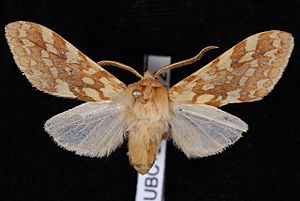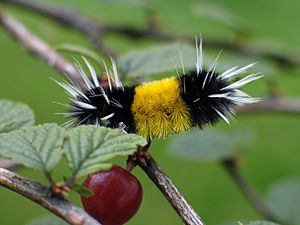Spotted tussock moth facts for kids
Quick facts for kids Spotted tussock moth |
|
|---|---|
 |
|
 |
|
| Scientific classification | |
| Genus: |
Lophocampa
|
| Species: |
maculata
|
| Synonyms | |
|
|
The spotted tussock moth (Lophocampa maculata) is a type of moth that belongs to the Erebidae family. It is also called the mottled tiger or spotted halisidota. This moth was first described by Thaddeus William Harris in 1841.
You can find the spotted tussock moth all across Canada and in the western parts of the United States. It also lives in the Appalachian Mountains, reaching as far south as South Carolina and Kentucky.
Contents
About the Spotted Tussock Moth
What Does It Look Like?
The spotted tussock moth has a wingspan of about 35 to 45 millimeters. That's about the length of two to three paper clips! These moths usually fly from May to July each year.
The caterpillars of this moth are quite unique. They are often called "tussock moths" because of the fuzzy tufts of hair on their bodies. A "tussock" is like a small clump or hill of grass or hair.
Life Cycle
The caterpillars, also known as larvae, are usually seen from July to September. The moth has one generation each year. This means they complete their entire life cycle, from egg to adult, once a year.
The caterpillars go through five different growth stages, called instars. In their final stage, they are black at both ends. The middle part of their body is yellow or orange. Some caterpillars even have black spots on their yellow or orange sections.
What Do They Eat?
Spotted tussock moth caterpillars enjoy eating the leaves of poplar and willow trees. They also like to munch on other trees. These include alder, basswood, birch, maple, and oak.
Subspecies
There are a few different types, or subspecies, of the spotted tussock moth:
- Lophocampa maculata maculata
- Lophocampa maculata agassizii (found in California and British Columbia)
- Lophocampa maculata texana (found in Texas)

